Social Media & Public Sphere: Impact of YouTubers and Bloggers
VerifiedAdded on 2023/06/05
|9
|2768
|171
Report
AI Summary
This report examines the impact of social media on the public sphere, focusing on the role of YouTubers, bloggers, and beauty vloggers. It discusses how social media enhances the public sphere by providing a platform for individuals to share their views and opinions, contributing to globalization and increased connectivity. The report analyzes both the positive and negative influences of social media, including its role in commercialization and the spread of tabloid content. It also relates the user agency theory and globalization theory to the case, highlighting how influencers act as agents affecting the principals (social media users). The findings suggest that social media has transformed the public sphere, enabling communication across geographical boundaries and promoting the sharing of information, while also presenting challenges related to commercialization and the potential for negative influence. The report concludes that social media has significantly impacted the public sphere, facilitating globalization and information sharing, but also necessitating critical evaluation of its effects.
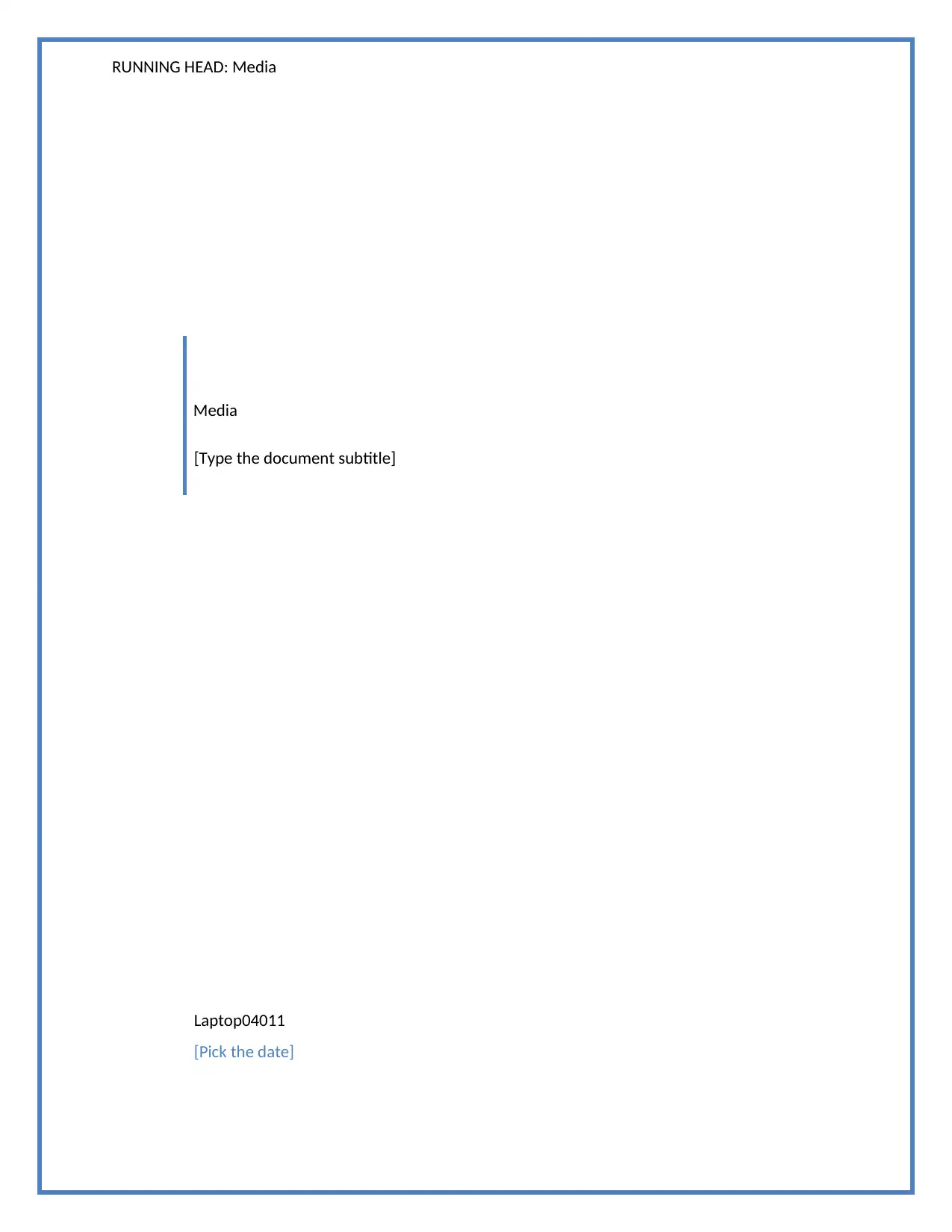
RUNNING HEAD: Media
Media
[Type the document subtitle]
Laptop04011
[Pick the date]
Media
[Type the document subtitle]
Laptop04011
[Pick the date]
Paraphrase This Document
Need a fresh take? Get an instant paraphrase of this document with our AI Paraphraser
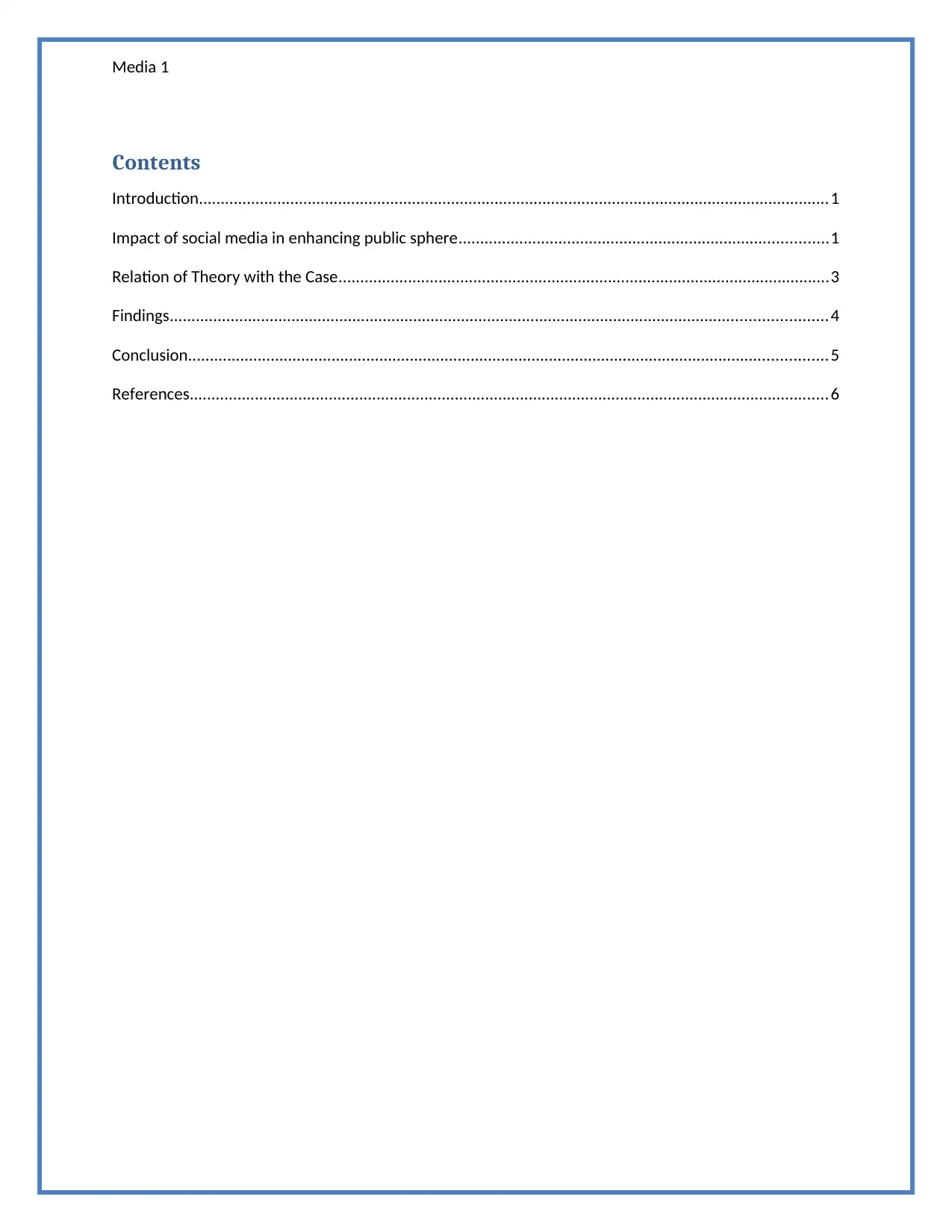
Media 1
Contents
Introduction.................................................................................................................................................1
Impact of social media in enhancing public sphere.....................................................................................1
Relation of Theory with the Case.................................................................................................................3
Findings.......................................................................................................................................................4
Conclusion...................................................................................................................................................5
References...................................................................................................................................................6
Contents
Introduction.................................................................................................................................................1
Impact of social media in enhancing public sphere.....................................................................................1
Relation of Theory with the Case.................................................................................................................3
Findings.......................................................................................................................................................4
Conclusion...................................................................................................................................................5
References...................................................................................................................................................6
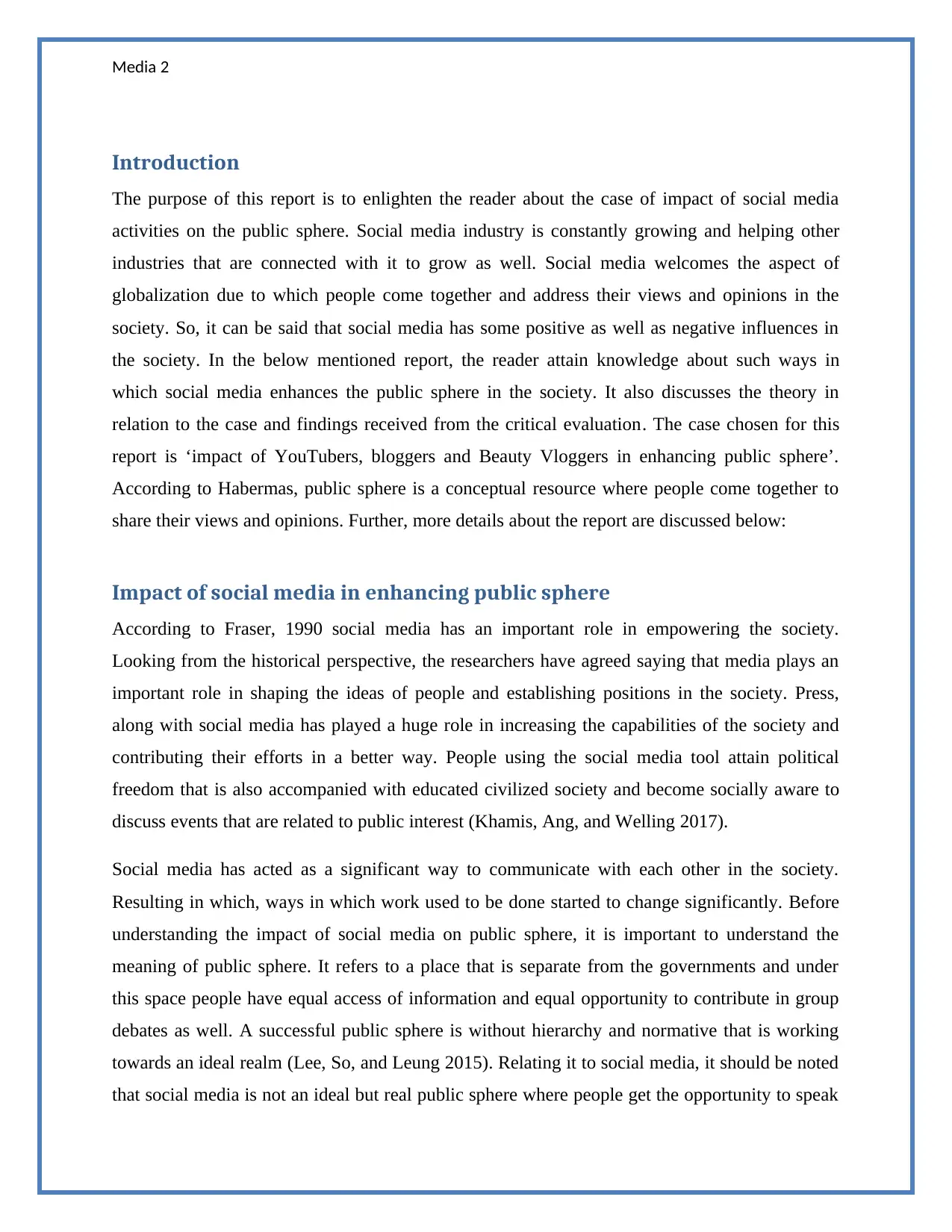
Media 2
Introduction
The purpose of this report is to enlighten the reader about the case of impact of social media
activities on the public sphere. Social media industry is constantly growing and helping other
industries that are connected with it to grow as well. Social media welcomes the aspect of
globalization due to which people come together and address their views and opinions in the
society. So, it can be said that social media has some positive as well as negative influences in
the society. In the below mentioned report, the reader attain knowledge about such ways in
which social media enhances the public sphere in the society. It also discusses the theory in
relation to the case and findings received from the critical evaluation. The case chosen for this
report is ‘impact of YouTubers, bloggers and Beauty Vloggers in enhancing public sphere’.
According to Habermas, public sphere is a conceptual resource where people come together to
share their views and opinions. Further, more details about the report are discussed below:
Impact of social media in enhancing public sphere
According to Fraser, 1990 social media has an important role in empowering the society.
Looking from the historical perspective, the researchers have agreed saying that media plays an
important role in shaping the ideas of people and establishing positions in the society. Press,
along with social media has played a huge role in increasing the capabilities of the society and
contributing their efforts in a better way. People using the social media tool attain political
freedom that is also accompanied with educated civilized society and become socially aware to
discuss events that are related to public interest (Khamis, Ang, and Welling 2017).
Social media has acted as a significant way to communicate with each other in the society.
Resulting in which, ways in which work used to be done started to change significantly. Before
understanding the impact of social media on public sphere, it is important to understand the
meaning of public sphere. It refers to a place that is separate from the governments and under
this space people have equal access of information and equal opportunity to contribute in group
debates as well. A successful public sphere is without hierarchy and normative that is working
towards an ideal realm (Lee, So, and Leung 2015). Relating it to social media, it should be noted
that social media is not an ideal but real public sphere where people get the opportunity to speak
Introduction
The purpose of this report is to enlighten the reader about the case of impact of social media
activities on the public sphere. Social media industry is constantly growing and helping other
industries that are connected with it to grow as well. Social media welcomes the aspect of
globalization due to which people come together and address their views and opinions in the
society. So, it can be said that social media has some positive as well as negative influences in
the society. In the below mentioned report, the reader attain knowledge about such ways in
which social media enhances the public sphere in the society. It also discusses the theory in
relation to the case and findings received from the critical evaluation. The case chosen for this
report is ‘impact of YouTubers, bloggers and Beauty Vloggers in enhancing public sphere’.
According to Habermas, public sphere is a conceptual resource where people come together to
share their views and opinions. Further, more details about the report are discussed below:
Impact of social media in enhancing public sphere
According to Fraser, 1990 social media has an important role in empowering the society.
Looking from the historical perspective, the researchers have agreed saying that media plays an
important role in shaping the ideas of people and establishing positions in the society. Press,
along with social media has played a huge role in increasing the capabilities of the society and
contributing their efforts in a better way. People using the social media tool attain political
freedom that is also accompanied with educated civilized society and become socially aware to
discuss events that are related to public interest (Khamis, Ang, and Welling 2017).
Social media has acted as a significant way to communicate with each other in the society.
Resulting in which, ways in which work used to be done started to change significantly. Before
understanding the impact of social media on public sphere, it is important to understand the
meaning of public sphere. It refers to a place that is separate from the governments and under
this space people have equal access of information and equal opportunity to contribute in group
debates as well. A successful public sphere is without hierarchy and normative that is working
towards an ideal realm (Lee, So, and Leung 2015). Relating it to social media, it should be noted
that social media is not an ideal but real public sphere where people get the opportunity to speak
⊘ This is a preview!⊘
Do you want full access?
Subscribe today to unlock all pages.

Trusted by 1+ million students worldwide
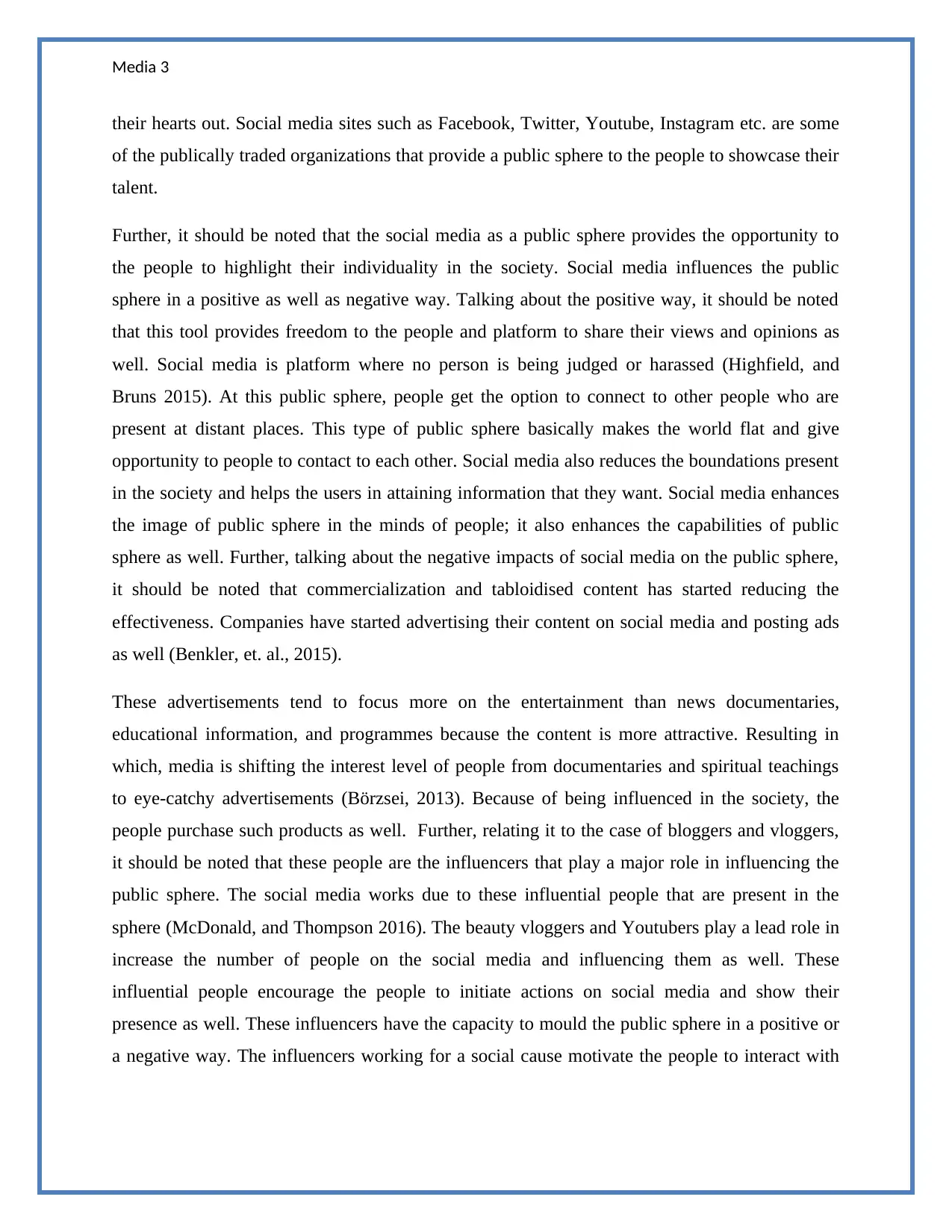
Media 3
their hearts out. Social media sites such as Facebook, Twitter, Youtube, Instagram etc. are some
of the publically traded organizations that provide a public sphere to the people to showcase their
talent.
Further, it should be noted that the social media as a public sphere provides the opportunity to
the people to highlight their individuality in the society. Social media influences the public
sphere in a positive as well as negative way. Talking about the positive way, it should be noted
that this tool provides freedom to the people and platform to share their views and opinions as
well. Social media is platform where no person is being judged or harassed (Highfield, and
Bruns 2015). At this public sphere, people get the option to connect to other people who are
present at distant places. This type of public sphere basically makes the world flat and give
opportunity to people to contact to each other. Social media also reduces the boundations present
in the society and helps the users in attaining information that they want. Social media enhances
the image of public sphere in the minds of people; it also enhances the capabilities of public
sphere as well. Further, talking about the negative impacts of social media on the public sphere,
it should be noted that commercialization and tabloidised content has started reducing the
effectiveness. Companies have started advertising their content on social media and posting ads
as well (Benkler, et. al., 2015).
These advertisements tend to focus more on the entertainment than news documentaries,
educational information, and programmes because the content is more attractive. Resulting in
which, media is shifting the interest level of people from documentaries and spiritual teachings
to eye-catchy advertisements (Börzsei, 2013). Because of being influenced in the society, the
people purchase such products as well. Further, relating it to the case of bloggers and vloggers,
it should be noted that these people are the influencers that play a major role in influencing the
public sphere. The social media works due to these influential people that are present in the
sphere (McDonald, and Thompson 2016). The beauty vloggers and Youtubers play a lead role in
increase the number of people on the social media and influencing them as well. These
influential people encourage the people to initiate actions on social media and show their
presence as well. These influencers have the capacity to mould the public sphere in a positive or
a negative way. The influencers working for a social cause motivate the people to interact with
their hearts out. Social media sites such as Facebook, Twitter, Youtube, Instagram etc. are some
of the publically traded organizations that provide a public sphere to the people to showcase their
talent.
Further, it should be noted that the social media as a public sphere provides the opportunity to
the people to highlight their individuality in the society. Social media influences the public
sphere in a positive as well as negative way. Talking about the positive way, it should be noted
that this tool provides freedom to the people and platform to share their views and opinions as
well. Social media is platform where no person is being judged or harassed (Highfield, and
Bruns 2015). At this public sphere, people get the option to connect to other people who are
present at distant places. This type of public sphere basically makes the world flat and give
opportunity to people to contact to each other. Social media also reduces the boundations present
in the society and helps the users in attaining information that they want. Social media enhances
the image of public sphere in the minds of people; it also enhances the capabilities of public
sphere as well. Further, talking about the negative impacts of social media on the public sphere,
it should be noted that commercialization and tabloidised content has started reducing the
effectiveness. Companies have started advertising their content on social media and posting ads
as well (Benkler, et. al., 2015).
These advertisements tend to focus more on the entertainment than news documentaries,
educational information, and programmes because the content is more attractive. Resulting in
which, media is shifting the interest level of people from documentaries and spiritual teachings
to eye-catchy advertisements (Börzsei, 2013). Because of being influenced in the society, the
people purchase such products as well. Further, relating it to the case of bloggers and vloggers,
it should be noted that these people are the influencers that play a major role in influencing the
public sphere. The social media works due to these influential people that are present in the
sphere (McDonald, and Thompson 2016). The beauty vloggers and Youtubers play a lead role in
increase the number of people on the social media and influencing them as well. These
influential people encourage the people to initiate actions on social media and show their
presence as well. These influencers have the capacity to mould the public sphere in a positive or
a negative way. The influencers working for a social cause motivate the people to interact with
Paraphrase This Document
Need a fresh take? Get an instant paraphrase of this document with our AI Paraphraser
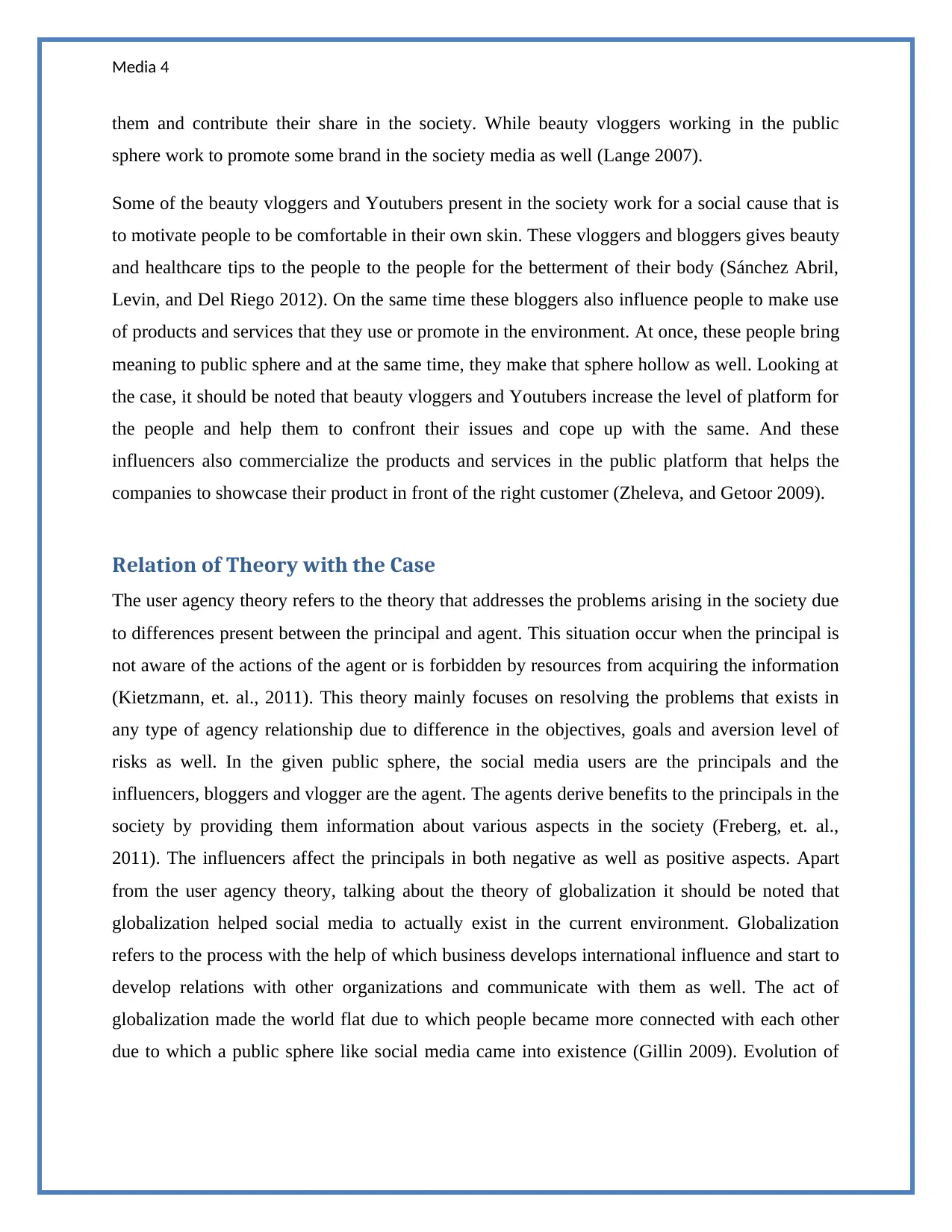
Media 4
them and contribute their share in the society. While beauty vloggers working in the public
sphere work to promote some brand in the society media as well (Lange 2007).
Some of the beauty vloggers and Youtubers present in the society work for a social cause that is
to motivate people to be comfortable in their own skin. These vloggers and bloggers gives beauty
and healthcare tips to the people to the people for the betterment of their body (Sánchez Abril,
Levin, and Del Riego 2012). On the same time these bloggers also influence people to make use
of products and services that they use or promote in the environment. At once, these people bring
meaning to public sphere and at the same time, they make that sphere hollow as well. Looking at
the case, it should be noted that beauty vloggers and Youtubers increase the level of platform for
the people and help them to confront their issues and cope up with the same. And these
influencers also commercialize the products and services in the public platform that helps the
companies to showcase their product in front of the right customer (Zheleva, and Getoor 2009).
Relation of Theory with the Case
The user agency theory refers to the theory that addresses the problems arising in the society due
to differences present between the principal and agent. This situation occur when the principal is
not aware of the actions of the agent or is forbidden by resources from acquiring the information
(Kietzmann, et. al., 2011). This theory mainly focuses on resolving the problems that exists in
any type of agency relationship due to difference in the objectives, goals and aversion level of
risks as well. In the given public sphere, the social media users are the principals and the
influencers, bloggers and vlogger are the agent. The agents derive benefits to the principals in the
society by providing them information about various aspects in the society (Freberg, et. al.,
2011). The influencers affect the principals in both negative as well as positive aspects. Apart
from the user agency theory, talking about the theory of globalization it should be noted that
globalization helped social media to actually exist in the current environment. Globalization
refers to the process with the help of which business develops international influence and start to
develop relations with other organizations and communicate with them as well. The act of
globalization made the world flat due to which people became more connected with each other
due to which a public sphere like social media came into existence (Gillin 2009). Evolution of
them and contribute their share in the society. While beauty vloggers working in the public
sphere work to promote some brand in the society media as well (Lange 2007).
Some of the beauty vloggers and Youtubers present in the society work for a social cause that is
to motivate people to be comfortable in their own skin. These vloggers and bloggers gives beauty
and healthcare tips to the people to the people for the betterment of their body (Sánchez Abril,
Levin, and Del Riego 2012). On the same time these bloggers also influence people to make use
of products and services that they use or promote in the environment. At once, these people bring
meaning to public sphere and at the same time, they make that sphere hollow as well. Looking at
the case, it should be noted that beauty vloggers and Youtubers increase the level of platform for
the people and help them to confront their issues and cope up with the same. And these
influencers also commercialize the products and services in the public platform that helps the
companies to showcase their product in front of the right customer (Zheleva, and Getoor 2009).
Relation of Theory with the Case
The user agency theory refers to the theory that addresses the problems arising in the society due
to differences present between the principal and agent. This situation occur when the principal is
not aware of the actions of the agent or is forbidden by resources from acquiring the information
(Kietzmann, et. al., 2011). This theory mainly focuses on resolving the problems that exists in
any type of agency relationship due to difference in the objectives, goals and aversion level of
risks as well. In the given public sphere, the social media users are the principals and the
influencers, bloggers and vlogger are the agent. The agents derive benefits to the principals in the
society by providing them information about various aspects in the society (Freberg, et. al.,
2011). The influencers affect the principals in both negative as well as positive aspects. Apart
from the user agency theory, talking about the theory of globalization it should be noted that
globalization helped social media to actually exist in the current environment. Globalization
refers to the process with the help of which business develops international influence and start to
develop relations with other organizations and communicate with them as well. The act of
globalization made the world flat due to which people became more connected with each other
due to which a public sphere like social media came into existence (Gillin 2009). Evolution of
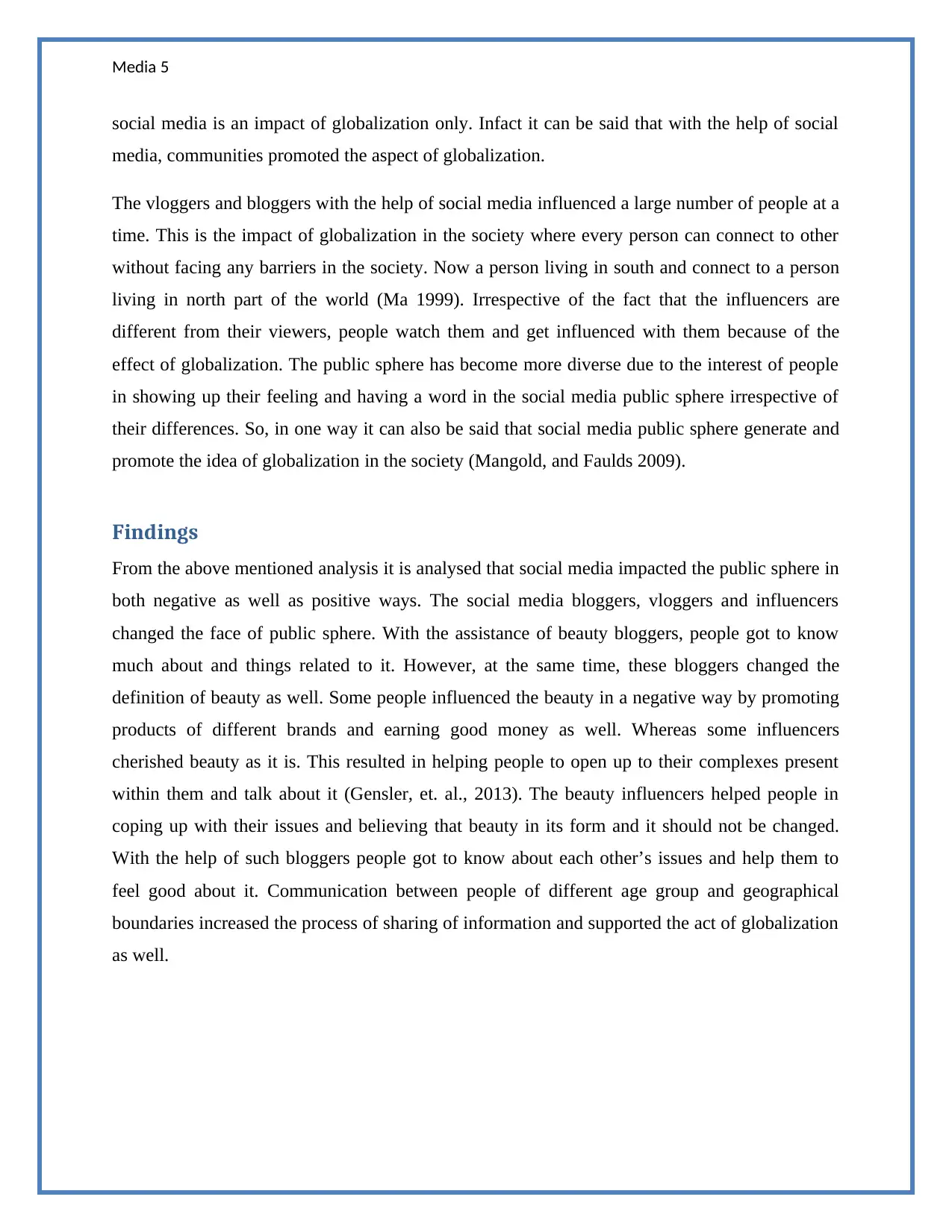
Media 5
social media is an impact of globalization only. Infact it can be said that with the help of social
media, communities promoted the aspect of globalization.
The vloggers and bloggers with the help of social media influenced a large number of people at a
time. This is the impact of globalization in the society where every person can connect to other
without facing any barriers in the society. Now a person living in south and connect to a person
living in north part of the world (Ma 1999). Irrespective of the fact that the influencers are
different from their viewers, people watch them and get influenced with them because of the
effect of globalization. The public sphere has become more diverse due to the interest of people
in showing up their feeling and having a word in the social media public sphere irrespective of
their differences. So, in one way it can also be said that social media public sphere generate and
promote the idea of globalization in the society (Mangold, and Faulds 2009).
Findings
From the above mentioned analysis it is analysed that social media impacted the public sphere in
both negative as well as positive ways. The social media bloggers, vloggers and influencers
changed the face of public sphere. With the assistance of beauty bloggers, people got to know
much about and things related to it. However, at the same time, these bloggers changed the
definition of beauty as well. Some people influenced the beauty in a negative way by promoting
products of different brands and earning good money as well. Whereas some influencers
cherished beauty as it is. This resulted in helping people to open up to their complexes present
within them and talk about it (Gensler, et. al., 2013). The beauty influencers helped people in
coping up with their issues and believing that beauty in its form and it should not be changed.
With the help of such bloggers people got to know about each other’s issues and help them to
feel good about it. Communication between people of different age group and geographical
boundaries increased the process of sharing of information and supported the act of globalization
as well.
social media is an impact of globalization only. Infact it can be said that with the help of social
media, communities promoted the aspect of globalization.
The vloggers and bloggers with the help of social media influenced a large number of people at a
time. This is the impact of globalization in the society where every person can connect to other
without facing any barriers in the society. Now a person living in south and connect to a person
living in north part of the world (Ma 1999). Irrespective of the fact that the influencers are
different from their viewers, people watch them and get influenced with them because of the
effect of globalization. The public sphere has become more diverse due to the interest of people
in showing up their feeling and having a word in the social media public sphere irrespective of
their differences. So, in one way it can also be said that social media public sphere generate and
promote the idea of globalization in the society (Mangold, and Faulds 2009).
Findings
From the above mentioned analysis it is analysed that social media impacted the public sphere in
both negative as well as positive ways. The social media bloggers, vloggers and influencers
changed the face of public sphere. With the assistance of beauty bloggers, people got to know
much about and things related to it. However, at the same time, these bloggers changed the
definition of beauty as well. Some people influenced the beauty in a negative way by promoting
products of different brands and earning good money as well. Whereas some influencers
cherished beauty as it is. This resulted in helping people to open up to their complexes present
within them and talk about it (Gensler, et. al., 2013). The beauty influencers helped people in
coping up with their issues and believing that beauty in its form and it should not be changed.
With the help of such bloggers people got to know about each other’s issues and help them to
feel good about it. Communication between people of different age group and geographical
boundaries increased the process of sharing of information and supported the act of globalization
as well.
⊘ This is a preview!⊘
Do you want full access?
Subscribe today to unlock all pages.

Trusted by 1+ million students worldwide
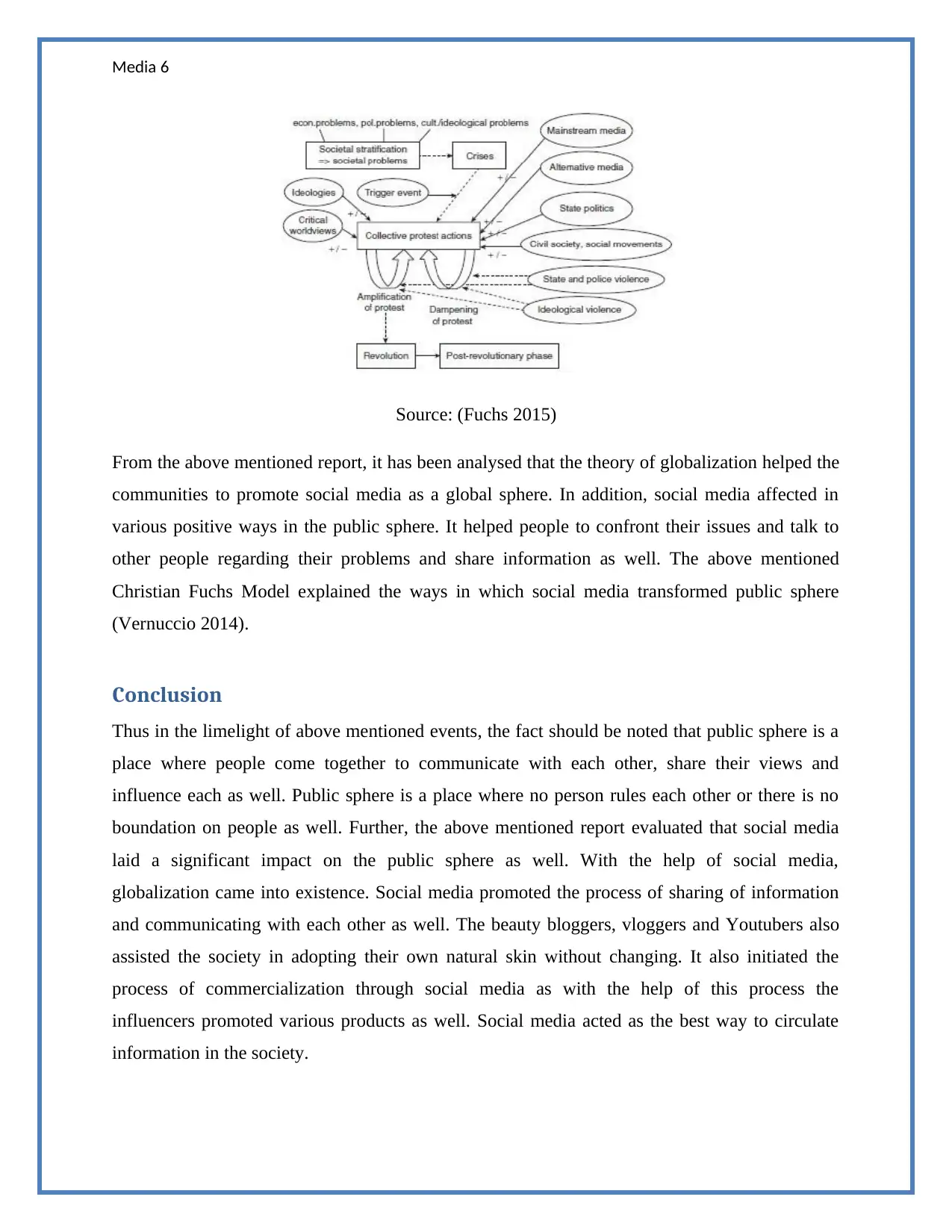
Media 6
Source: (Fuchs 2015)
From the above mentioned report, it has been analysed that the theory of globalization helped the
communities to promote social media as a global sphere. In addition, social media affected in
various positive ways in the public sphere. It helped people to confront their issues and talk to
other people regarding their problems and share information as well. The above mentioned
Christian Fuchs Model explained the ways in which social media transformed public sphere
(Vernuccio 2014).
Conclusion
Thus in the limelight of above mentioned events, the fact should be noted that public sphere is a
place where people come together to communicate with each other, share their views and
influence each as well. Public sphere is a place where no person rules each other or there is no
boundation on people as well. Further, the above mentioned report evaluated that social media
laid a significant impact on the public sphere as well. With the help of social media,
globalization came into existence. Social media promoted the process of sharing of information
and communicating with each other as well. The beauty bloggers, vloggers and Youtubers also
assisted the society in adopting their own natural skin without changing. It also initiated the
process of commercialization through social media as with the help of this process the
influencers promoted various products as well. Social media acted as the best way to circulate
information in the society.
Source: (Fuchs 2015)
From the above mentioned report, it has been analysed that the theory of globalization helped the
communities to promote social media as a global sphere. In addition, social media affected in
various positive ways in the public sphere. It helped people to confront their issues and talk to
other people regarding their problems and share information as well. The above mentioned
Christian Fuchs Model explained the ways in which social media transformed public sphere
(Vernuccio 2014).
Conclusion
Thus in the limelight of above mentioned events, the fact should be noted that public sphere is a
place where people come together to communicate with each other, share their views and
influence each as well. Public sphere is a place where no person rules each other or there is no
boundation on people as well. Further, the above mentioned report evaluated that social media
laid a significant impact on the public sphere as well. With the help of social media,
globalization came into existence. Social media promoted the process of sharing of information
and communicating with each other as well. The beauty bloggers, vloggers and Youtubers also
assisted the society in adopting their own natural skin without changing. It also initiated the
process of commercialization through social media as with the help of this process the
influencers promoted various products as well. Social media acted as the best way to circulate
information in the society.
Paraphrase This Document
Need a fresh take? Get an instant paraphrase of this document with our AI Paraphraser
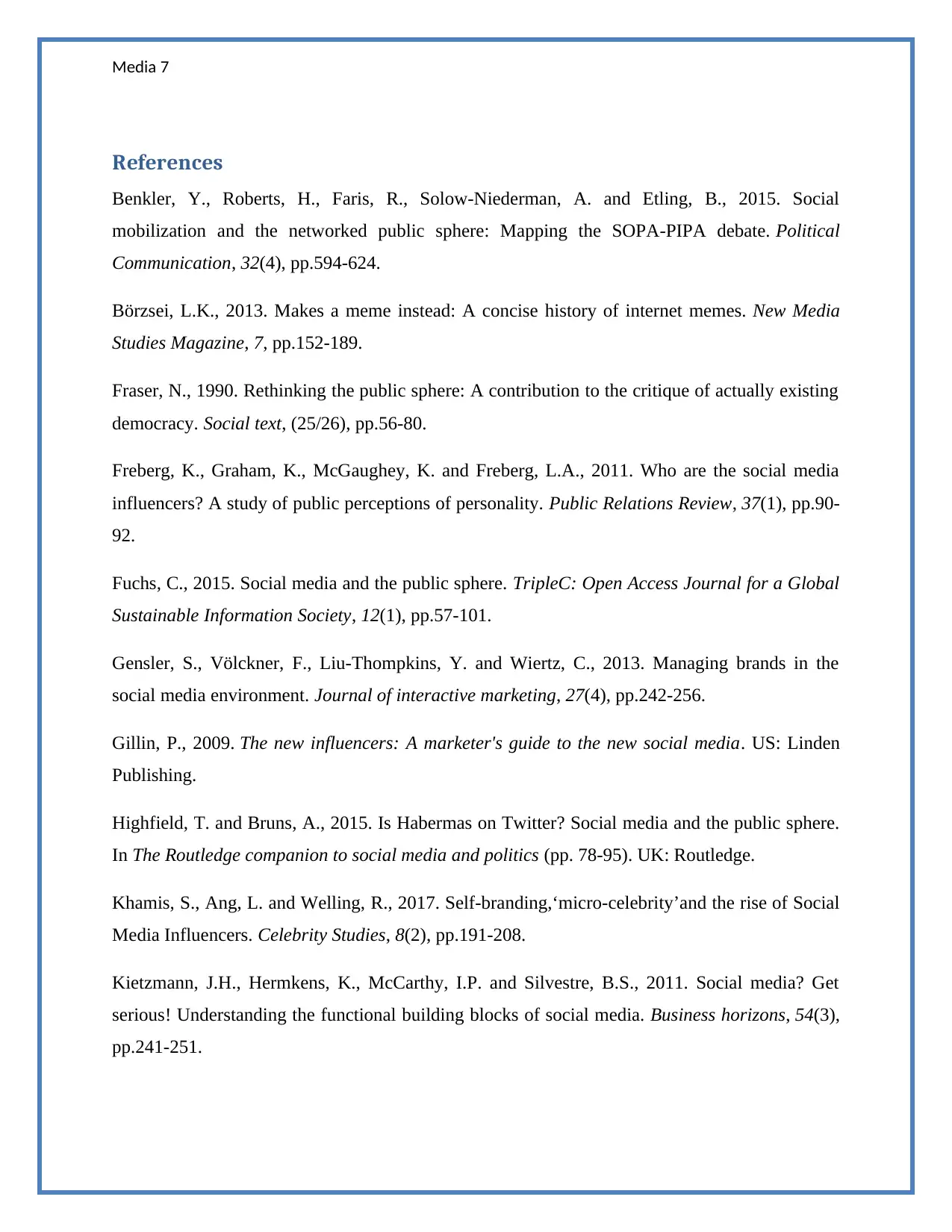
Media 7
References
Benkler, Y., Roberts, H., Faris, R., Solow-Niederman, A. and Etling, B., 2015. Social
mobilization and the networked public sphere: Mapping the SOPA-PIPA debate. Political
Communication, 32(4), pp.594-624.
Börzsei, L.K., 2013. Makes a meme instead: A concise history of internet memes. New Media
Studies Magazine, 7, pp.152-189.
Fraser, N., 1990. Rethinking the public sphere: A contribution to the critique of actually existing
democracy. Social text, (25/26), pp.56-80.
Freberg, K., Graham, K., McGaughey, K. and Freberg, L.A., 2011. Who are the social media
influencers? A study of public perceptions of personality. Public Relations Review, 37(1), pp.90-
92.
Fuchs, C., 2015. Social media and the public sphere. TripleC: Open Access Journal for a Global
Sustainable Information Society, 12(1), pp.57-101.
Gensler, S., Völckner, F., Liu-Thompkins, Y. and Wiertz, C., 2013. Managing brands in the
social media environment. Journal of interactive marketing, 27(4), pp.242-256.
Gillin, P., 2009. The new influencers: A marketer's guide to the new social media. US: Linden
Publishing.
Highfield, T. and Bruns, A., 2015. Is Habermas on Twitter? Social media and the public sphere.
In The Routledge companion to social media and politics (pp. 78-95). UK: Routledge.
Khamis, S., Ang, L. and Welling, R., 2017. Self-branding,‘micro-celebrity’and the rise of Social
Media Influencers. Celebrity Studies, 8(2), pp.191-208.
Kietzmann, J.H., Hermkens, K., McCarthy, I.P. and Silvestre, B.S., 2011. Social media? Get
serious! Understanding the functional building blocks of social media. Business horizons, 54(3),
pp.241-251.
References
Benkler, Y., Roberts, H., Faris, R., Solow-Niederman, A. and Etling, B., 2015. Social
mobilization and the networked public sphere: Mapping the SOPA-PIPA debate. Political
Communication, 32(4), pp.594-624.
Börzsei, L.K., 2013. Makes a meme instead: A concise history of internet memes. New Media
Studies Magazine, 7, pp.152-189.
Fraser, N., 1990. Rethinking the public sphere: A contribution to the critique of actually existing
democracy. Social text, (25/26), pp.56-80.
Freberg, K., Graham, K., McGaughey, K. and Freberg, L.A., 2011. Who are the social media
influencers? A study of public perceptions of personality. Public Relations Review, 37(1), pp.90-
92.
Fuchs, C., 2015. Social media and the public sphere. TripleC: Open Access Journal for a Global
Sustainable Information Society, 12(1), pp.57-101.
Gensler, S., Völckner, F., Liu-Thompkins, Y. and Wiertz, C., 2013. Managing brands in the
social media environment. Journal of interactive marketing, 27(4), pp.242-256.
Gillin, P., 2009. The new influencers: A marketer's guide to the new social media. US: Linden
Publishing.
Highfield, T. and Bruns, A., 2015. Is Habermas on Twitter? Social media and the public sphere.
In The Routledge companion to social media and politics (pp. 78-95). UK: Routledge.
Khamis, S., Ang, L. and Welling, R., 2017. Self-branding,‘micro-celebrity’and the rise of Social
Media Influencers. Celebrity Studies, 8(2), pp.191-208.
Kietzmann, J.H., Hermkens, K., McCarthy, I.P. and Silvestre, B.S., 2011. Social media? Get
serious! Understanding the functional building blocks of social media. Business horizons, 54(3),
pp.241-251.
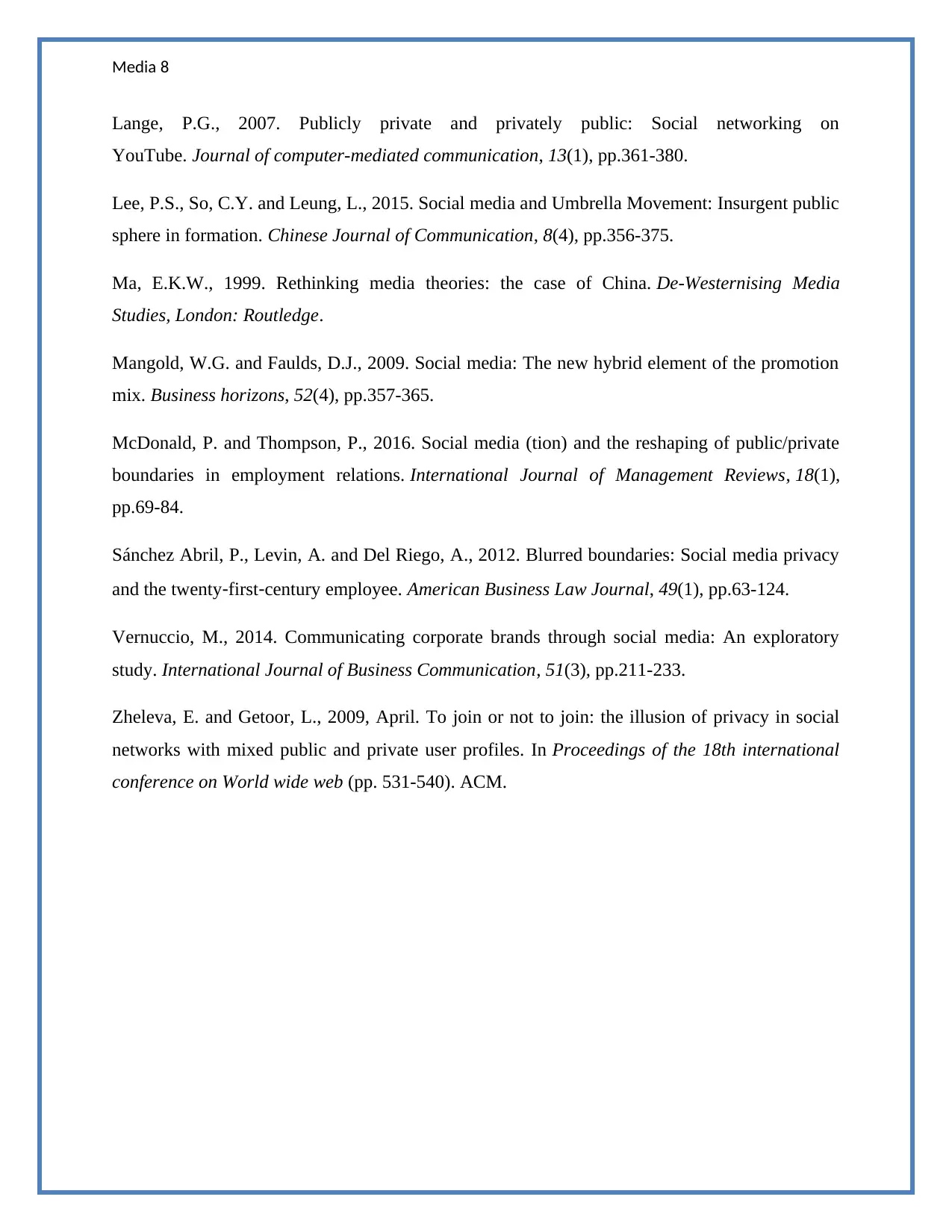
Media 8
Lange, P.G., 2007. Publicly private and privately public: Social networking on
YouTube. Journal of computer-mediated communication, 13(1), pp.361-380.
Lee, P.S., So, C.Y. and Leung, L., 2015. Social media and Umbrella Movement: Insurgent public
sphere in formation. Chinese Journal of Communication, 8(4), pp.356-375.
Ma, E.K.W., 1999. Rethinking media theories: the case of China. De-Westernising Media
Studies, London: Routledge.
Mangold, W.G. and Faulds, D.J., 2009. Social media: The new hybrid element of the promotion
mix. Business horizons, 52(4), pp.357-365.
McDonald, P. and Thompson, P., 2016. Social media (tion) and the reshaping of public/private
boundaries in employment relations. International Journal of Management Reviews, 18(1),
pp.69-84.
Sánchez Abril, P., Levin, A. and Del Riego, A., 2012. Blurred boundaries: Social media privacy
and the twenty‐first‐century employee. American Business Law Journal, 49(1), pp.63-124.
Vernuccio, M., 2014. Communicating corporate brands through social media: An exploratory
study. International Journal of Business Communication, 51(3), pp.211-233.
Zheleva, E. and Getoor, L., 2009, April. To join or not to join: the illusion of privacy in social
networks with mixed public and private user profiles. In Proceedings of the 18th international
conference on World wide web (pp. 531-540). ACM.
Lange, P.G., 2007. Publicly private and privately public: Social networking on
YouTube. Journal of computer-mediated communication, 13(1), pp.361-380.
Lee, P.S., So, C.Y. and Leung, L., 2015. Social media and Umbrella Movement: Insurgent public
sphere in formation. Chinese Journal of Communication, 8(4), pp.356-375.
Ma, E.K.W., 1999. Rethinking media theories: the case of China. De-Westernising Media
Studies, London: Routledge.
Mangold, W.G. and Faulds, D.J., 2009. Social media: The new hybrid element of the promotion
mix. Business horizons, 52(4), pp.357-365.
McDonald, P. and Thompson, P., 2016. Social media (tion) and the reshaping of public/private
boundaries in employment relations. International Journal of Management Reviews, 18(1),
pp.69-84.
Sánchez Abril, P., Levin, A. and Del Riego, A., 2012. Blurred boundaries: Social media privacy
and the twenty‐first‐century employee. American Business Law Journal, 49(1), pp.63-124.
Vernuccio, M., 2014. Communicating corporate brands through social media: An exploratory
study. International Journal of Business Communication, 51(3), pp.211-233.
Zheleva, E. and Getoor, L., 2009, April. To join or not to join: the illusion of privacy in social
networks with mixed public and private user profiles. In Proceedings of the 18th international
conference on World wide web (pp. 531-540). ACM.
⊘ This is a preview!⊘
Do you want full access?
Subscribe today to unlock all pages.

Trusted by 1+ million students worldwide
1 out of 9
Related Documents
Your All-in-One AI-Powered Toolkit for Academic Success.
+13062052269
info@desklib.com
Available 24*7 on WhatsApp / Email
![[object Object]](/_next/static/media/star-bottom.7253800d.svg)
Unlock your academic potential
Copyright © 2020–2025 A2Z Services. All Rights Reserved. Developed and managed by ZUCOL.





